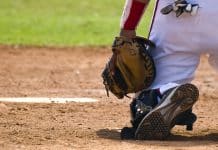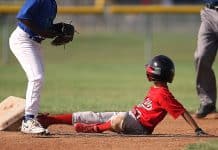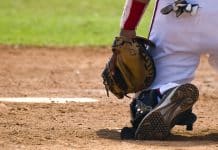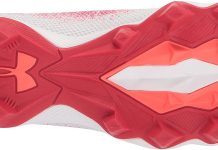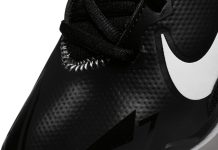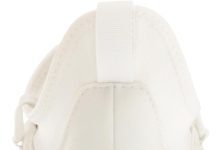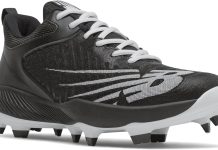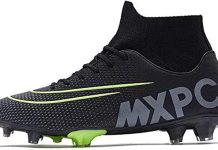If your kid is an avid athlete and loves both soccer and baseball, you may find yourself wondering if their soccer cleats can be used for baseball as well. While the two sports share similarities, it’s important to consider the specific requirements and demands of each game. In this article, we’ll explore whether or not it’s appropriate for your child to wear soccer cleats for baseball, taking into account factors such as safety, performance, and comfort.
Benefits of Wearing Soccer Cleats for Baseball
Review contents
Improved Speed and Agility
Wearing soccer cleats for baseball can provide significant benefits when it comes to speed and agility on the field. Soccer cleats are designed to be lightweight and provide excellent traction, allowing you to accelerate quickly and make quick cuts in any direction. This enhanced speed and agility can give you a competitive edge in baseball, whether you’re trying to steal a base or chase down a fly ball in the outfield.
Enhanced Traction
Traction is crucial in baseball, as it helps players maintain stability and prevent slipping, especially on grass surfaces. Soccer cleats typically have a greater number of studs compared to baseball cleats, which provides superior traction. The studs are strategically placed in various patterns to maximize grip on the playing surface, allowing you to make quick starts and stops without losing your footing.
Better Performance on Grass Surfaces
Baseball is predominantly played on grass fields, and soccer cleats are specifically designed to excel on such surfaces. The studs on soccer cleats penetrate the grass, providing stability and preventing slippage, even in wet conditions. This can be particularly advantageous in outfield positions where a strong grip is necessary to chase down fly balls or make quick turns when running the bases.
Versatility for Multiple Sports
One of the biggest advantages of soccer cleats is their versatility. Unlike baseball cleats, which are designed exclusively for baseball, soccer cleats can be used for various other sports. Whether it’s soccer, lacrosse, or rugby, having a pair of soccer cleats allows you to participate in different activities without needing to invest in multiple pairs of sport-specific footwear. This versatility makes soccer cleats a cost-effective option for young athletes who engage in various sports.
Differences Between Soccer Cleats and Baseball Cleats
Material and Construction
One of the primary differences between soccer cleats and baseball cleats lies in the materials used for their construction. Soccer cleats are typically made from synthetic materials such as synthetic leather or mesh, which provide a lightweight and breathable feel. In contrast, baseball cleats often have a sturdier construction, with materials such as genuine leather or synthetic leather, offering more durability and support.
Design and Studs
Another key distinction between soccer cleats and baseball cleats is their design and stud configuration. Soccer cleats generally have multiple studs evenly distributed across the outsole to enhance traction on grass. In contrast, baseball cleats often feature a combination of metal or molded cleats concentrated under the ball and heel of the foot, providing more stability and grip on dirt and turf surfaces.
Soles and Padding
The soles of soccer cleats are typically thinner compared to baseball cleats. This design choice allows for better ball control and increased ground feel when kicking a soccer ball. In contrast, baseball cleats often have thicker soles, providing more cushioning and support for the constant impact and lateral movements associated with baseball.
Toe and Heel
The design of the toe and heel areas also differs between soccer cleats and baseball cleats. Soccer cleats usually have a rounded or slightly pointed toe to allow for greater control while dribbling and striking the ball. Baseball cleats, on the other hand, often feature a reinforced toe box to protect against toe injuries, as well as a defined heel for additional stability during running and explosive movements.
Weight
Soccer cleats are typically lighter compared to baseball cleats. The lightweight design of soccer cleats aims to enhance speed and agility, allowing soccer players to move swiftly on the field. Baseball cleats, on the other hand, tend to have a slightly heavier construction, providing more stability and support for the lateral movements and quick bursts of speed required in baseball.
Considerations for Using Soccer Cleats in Baseball
Position Specificity
When considering using soccer cleats for baseball, it’s essential to take into account the specific position you play. While soccer cleats can provide advantages in terms of speed and agility, certain baseball positions may require specialized cleats. For example, pitchers often wear cleats with metal spikes or specialized toe cleats to gain traction and maintain stability on the pitching mound.
League Regulations
Before wearing soccer cleats for baseball, it’s vital to check your league’s regulations regarding footwear. Some baseball leagues require players to wear specific types of cleats to ensure fair play and prevent any potential injuries caused by improper footwear. Familiarize yourself with your league’s guidelines to avoid any violations that could result in penalties or disqualification.
Playing Surface
The type of playing surface can also impact the suitability of soccer cleats for baseball. If you primarily play on grass fields, soccer cleats should work well and provide excellent traction. However, if you frequently play on artificial turf or dirt surfaces, baseball cleats may offer better performance and stability due to their specialized design and stud configuration.
Weather Conditions
Consider the weather conditions you frequently encounter when deciding between soccer cleats and baseball cleats. Soccer cleats are often designed with features that make them more suitable for wet conditions, such as improved water resistance and stud patterns that provide enhanced grip on wet grass. Baseball cleats, on the other hand, may have features like water-resistant materials or specialized studs for optimal performance on dry or dirt surfaces.
Player Comfort and Safety
Comfort and safety should always be a top priority when choosing cleats for any sport. Everyone’s feet are different, and finding the right fit and level of comfort is crucial to ensure an enjoyable and injury-free experience on the field. Make sure to try on different cleat options and consider factors such as arch support, cushioning, and overall fit. Additionally, pay attention to the cleats’ ankle support, as soccer cleats often have a lower cut compared to baseball cleats, which may not provide as much stability and protection to the ankle joint.
Benefits of Baseball Cleats Over Soccer Cleats
Optimized Performance for Baseball Movements
Baseball cleats are specifically designed to optimize performance for the unique movements and demands of baseball. From the grip on different playing surfaces to the support provided during lateral movements, baseball cleats are crafted with the specific needs of baseball players in mind. This specialization can enhance your performance, allowing you to make quick turns, steal bases, and pivot with confidence.
Superior Lateral Support
Baseball involves a significant amount of lateral movements, such as quick changes in direction while fielding or running the bases. Baseball cleats typically offer superior lateral support compared to soccer cleats. The sturdier construction, along with the cleat placement, helps to stabilize the foot and ankle, reducing the risk of injuries and improving overall stability during lateral movements.
Protection and Durability
Baseball cleats often come with additional protective features to shield players from potential injuries. Reinforced toes and thickened soles provide extra durability and protection when sliding into bases, while also preventing injuries from impact with the ball or other players. Additionally, the sturdy construction of baseball cleats ensures they can withstand the rigors of the game for an extended period.
Meeting League Standards
Most baseball leagues have specific regulations regarding cleats to ensure player safety and maintain fairness. Baseball cleats are designed to meet these standards, ensuring that they comply with league rules and regulations. By wearing approved baseball cleats, you can avoid penalties or disqualification from games due to violations of these guidelines.
Reduced Risk of Injuries
The specialized design and construction of baseball cleats are aimed at reducing the risk of common baseball-related injuries. The added protection, sturdier construction, and support provided by baseball cleats can minimize the chances of ankle sprains, toe injuries, or even muscle strains that may result from wearing improper footwear. By using baseball cleats, you can help safeguard your feet and lower limbs while playing the game.
Potential Issues with Using Soccer Cleats for Baseball
Reduced Performance in Baseball-Specific Movements
While soccer cleats can offer advantages in terms of speed and agility, they may not provide the same level of performance when it comes to baseball-specific movements. The stud patterns and overall design of soccer cleats are optimized for soccer movements, and they may not offer the same level of stability, traction, or lateral support required in baseball.
Lack of Proper Ankle Support
Soccer cleats typically have a lower-cut design compared to baseball cleats, which may not provide adequate ankle support for the quick direction changes and lateral movements involved in baseball. Ankle support is crucial in preventing sprains and other ankle-related injuries, and the higher-cut design of baseball cleats offers added stability and protection to the ankle joint.
Inadequate Traction on Different Surfaces
While soccer cleats excel on grass, they may struggle to provide the same level of traction on dirt or artificial turf surfaces commonly found in baseball. The stud patterns and materials used in soccer cleats are not specifically designed for these surfaces, which may result in reduced grip and potential slipping. This can negatively impact your performance and increase the risk of injuries.
Violation of League Regulations
Using soccer cleats instead of approved baseball cleats may result in violations of league regulations. Most baseball leagues have specific guidelines regarding footwear, and failure to comply with these regulations may lead to penalties or disqualification from games. Make sure to check the rules of your league before deciding to wear soccer cleats for baseball.
Higher Risk of Injuries
Due to the differences in design and construction, using soccer cleats for baseball may potentially increase the risk of certain injuries. The lack of ankle support, reduced traction on different surfaces, and overall unsuitability for baseball-specific movements can contribute to a higher risk of ankle sprains, toe injuries, and slips that may result in more severe injuries.
Tips for Wearing Soccer Cleats in Baseball
Choose Synthetic Upper Materials
When selecting soccer cleats for baseball, opt for cleats with synthetic upper materials. Synthetic leather or mesh materials offer lightweight and breathable options that can keep your feet comfortable during games. The synthetic materials also tend to be more water-resistant compared to genuine leather, making them suitable for wet playing conditions.
Opt for Molded Cleats
If you decide to wear soccer cleats for baseball, choose ones with molded cleats instead of metal studs. Molded cleats provide better traction and stability on a variety of surfaces, including grass and artificial turf. They are also more likely to conform to league regulations that prohibit metal spikes, ensuring compliance with the rules and preventing potential penalties.
Add Removable Cleats
Some soccer cleats come with removable studs, allowing you to customize the type and configuration of cleats based on the playing surface. This versatility can be useful if you frequently encounter different field conditions. Consider investing in a pair of soccer cleats with removable studs to ensure optimal traction and performance in various baseball environments.
Consider Using Cleat Covers
To enhance the traction and grip of soccer cleats on different surfaces, you can use cleat covers or shoe traction devices. Cleat covers are rubber or silicone attachments that slip over your existing soccer cleats, providing additional grip on surfaces like dirt or turf. These covers can help mitigate the issue of inadequate traction, ensuring better performance and reducing the risk of slips or falls.
Consult with Coaches or Trainers
Before making the decision to wear soccer cleats for baseball, it’s recommended to consult with your coaches or trainers. They can offer valuable insights based on their experience and knowledge of the sport. Coaches or trainers may be aware of specific league regulations, field conditions, or potential safety concerns that can help you make an informed decision about your footwear.
Alternatives to Soccer Cleats for Baseball
Baseball Cleats
Baseball cleats are the most suitable footwear option for playing baseball. They are specifically designed to meet the demands of the sport, offering optimal performance on various playing surfaces. Baseball cleats provide a combination of features such as specialized stud patterns, ankle support, and durability that can enhance your performance and minimize the risk of injuries.
Multi-Sport Cleats
If you participate in multiple sports and don’t want to invest in separate cleats for each activity, multi-sport cleats can be a viable option. These cleats are designed to provide versatility across different sports, including baseball. Although they may not provide the same level of performance as specialized baseball cleats, multi-sport cleats can still offer decent support, traction, and comfort for recreational players or those engaged in multiple sporting activities.
Turf Shoes
Turf shoes are another alternative to soccer cleats for baseball, particularly if you frequently play on artificial turf surfaces. Turf shoes have a flat rubber outsole that provides excellent grip and traction on turf, without the use of spikes or studs. They offer good stability and are often lightweight, making them suitable for players who prioritize comfort and performance on artificial surfaces.
Training Shoes
Depending on the player’s age and skill level, training shoes can be a viable option for baseball. These shoes are designed for general training purposes and often offer a balance between comfort, support, and traction. While they may not be specifically designed for baseball movements, training shoes can be a suitable choice for players who engage in various training drills or practices, where specialized footwear is less critical.
Conclusion
While soccer cleats may offer certain benefits for baseball players, it’s essential to weigh the advantages against potential drawbacks. Improved speed and agility, enhanced traction on grass surfaces, and versatility for multiple sports are notable advantages of wearing soccer cleats for baseball. However, factors such as reduced performance in baseball-specific movements, inadequate ankle support, potential violations of league regulations, and increased risk of injuries should also be considered.
Before deciding to wear soccer cleats for baseball, it’s crucial to evaluate position specificity, league regulations, playing surface, weather conditions, and prioritized player comfort and safety. Additionally, exploring alternatives such as baseball cleats, multi-sport cleats, turf shoes, or training shoes can provide tailored options that better cater to the unique demands of the sport.
Remember, proper footwear is an essential aspect of performance and injury prevention in baseball. By taking into account all the necessary considerations and seeking guidance from coaches or trainers, you can make an informed decision to ensure an enjoyable and safe experience on the baseball field.
Additional Resources
- Equipment Guidelines by Baseball Associations
- Footwear Comparisons and Reviews
- Podcasts or Videos on Footwear Selection
- Expert Advice on Choosing the Right Cleats




